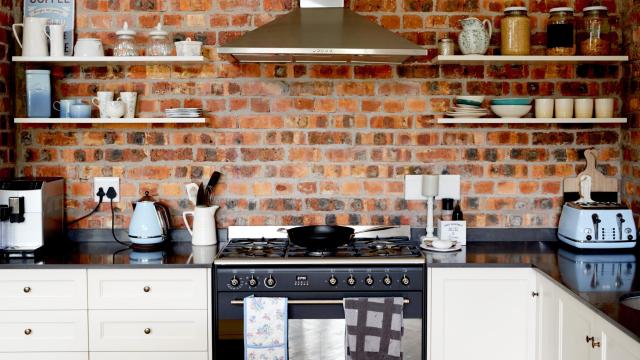Exposed brick walls can give your room a warm and rustic feel — but maintaining them can be more daunting than you might initially realise. You can bring them back to their former glory, though — or update them with some paint — by following these simple steps.
The tools and materials you need to repair exposed brick
To repair the mortar in your exposed brick wall, you’ll need a few tools and a little patience. A hammer, mortar chisel, and some masonry mortar are first on the list, as well as a wire brush. You will also need something to remove excess mortar and smooth your repairs. You can use a masonry trowel for this, but if this is a one-time project, a cheaper and simpler option is a metal spoon. You may also want to cover your floors with some masking paper or a drop cloth to make clean-up easier.
First, remove damaged, loose mortar
Begin by using your chisel to carefully remove any loose mortar from between your bricks, down to about ½ to 1 inch. If you have big gaps going deeper than that, it’s time to call a professional mason because there might be structural issues with your brick. Once you’ve cleaned out the damaged and loose mortar, use the wire brush to remove any stubborn bits and shards. Then, you’re ready to mix your mortar.
Apply new mortar
Following the instructions on the package, mix your mortar and apply in the space you’ve made between the bricks. Make sure to keep your damp rag ready to wipe away any excess mortar while it’s still wet — it will be much more difficult to remove once it’s dry. Use your mortar trowel or spoon to smooth the mortar, working first on the vertical spaces, then the horizontal ones between the bricks. Once the tucking is finished, let the mortar dry before sealing.
Seal your wall
The last step in restoring your newly repaired brick is to seal it to prevent future damage. For best results, use a water-based, flat sealer. This will keep the original finish on your brick while protecting the new mortar, and it will allow for an easy clean-up with no dangerous fumes.
Clean your exposed brick
To clean your exposed brick, avoid abrasive cleaners and materials because it can damage the wall. You can vacuum or dust your wall first with a feather duster, then use salt and dish detergent to clean the brick. Mix the salt and detergent 50/50 to get a paste-like texture, and then spread it over the wall with your hands or a wet rag. You can brush it in with a stiff bristle brush if your brick is newer, but do so gently. Allow it to sit for 10 minutes, then rinse. This should leave your brick clean and undamaged.
Painting, staining, or whitewashing
To prep for paint, stain, or whitewash, simply tape off any adjoining surfaces as you would before painting any wall. But before you do, keep in mind that these methods will require some maintenance — painted brick will need to be repainted every 3-5 years — and once you apply paint, stain, or whitewash, it is very difficult (and sometimes impossible) to reverse. So make sure it’s what you really want before you proceed.

Leave a Reply
You must be logged in to post a comment.